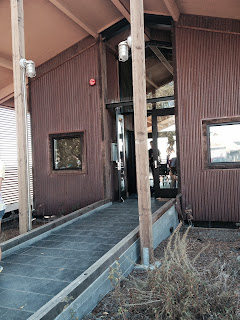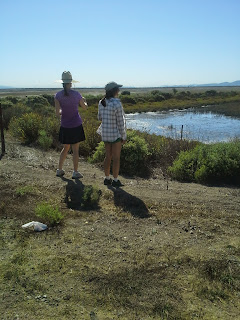The Sonoma Baylands
Restoration Project in the making!
Located at Sears Point
By Kelly Simon-Coghlan aka the awesomest van driver ever (:
On October 3, 2014 The Sonoma State University’s Restoration Ecology class visited the site of a large restoration project being undertaken by Sonoma Land Trust (SLT), I got to be a part of this trip. When first driving up it looks as if you are entering a ranch, until you pull up to the main building (which used to be a barn or ranch house?) It was re-designed pro-bono by the renowned architect Olle Lundberg who is now designing the Twitter building headquarters in San Francisco. It may not look like much from the picture but I stole another picture from the designer’s blog shown below this one. It has a deck that looks out over the field and as we were told has breathtaking views in the spring with all the flowers in bloom. Currently with no rain and two years of ongoing drought, it looked pretty dead and dry out there.
Sonoma Baylands building 2014
Julian Meisler is SLT’s Baylands program manager and the person who gave us the tour around the Baylands as well as a lot of information about how the land was aquisitioned. He also told us about how the Rohnert Park Graton Resort casino was almost going to be built right there on that spot where we were standing. He said from a zoning point, it was a fine place to put a very large casino. The Bay Institute, Sonoma Land Trust and Sonoma Ecology Center put together an 18 page document stating why building a casino in this spot would be a bad decision. The Federated Indians of the Graton Rancheria agreed. After seeing that the land should be protected, they donated their right to acquire the 2,327 acre Sears Point property as well as $75,000 (I looked the actual amount of $ money up). The tribe held on to five parcels totalling 321 acres of land but promised to donate it once they got their spot in Rohnert Park for the new casino, and in April of 2013 they did.
Another concern/problem was that there had been farmers on this land for generations and now people were coming in and telling them how they had to do things. Unfortunately a hunting area had to be closed down which caused a lot of friction as well. SLT works with the local ranchers and there are cattle that roam the property and help keep down many of the exotic weeds.
The area is broken up into sections of what will be done or is being done. The section closest to hwy 37 is the “upland enhancement” area, the middle section is the “seasonal wetland enhancement” area, and the area that is closest to the bay is the “tidal marsh” area. The marsh area is technically a “muted” marsh because the bay cannot come all the way in.
Here is the class hanging out on the back deck (yeah I know its dark)
We drove through a field (in the rented vans) through two gates and then to a large dug out dirt odd shaped pit in the ground. We were told it will be a red legged frog habitat. It also has variation in it’s depths. The problem is that last time it was filled with water the salinity was saltier than the ocean (which is not good for frogs). Julian told us the reason may be because of the salts left in the soil possibly from a salty aquifer underground, because the water that filled the pond was rain water. Hopefully that can be remedied. The odd shape/varied depths of the pond is to have special niches for the frogs. Julian told us an interesting fact about the red-legged frogs and the big problem of Bullfrogs being an invasive species and a huge threat. Red-legged frogs seem to do pretty well when ponds dry out for the season. They hide under leaves and are able to stay moist whereas the Bullfrogs take a long time to mature so if the pond dried up, they would all die as shriveled up little tadpoles.
Red-legged frog habitat
Below is a picture of a wetland area that they started working on in 1995. They had to bring in truck loads of sediment (literally). Cord grass is the first colonizer in mudflats and it eventually turns to pickleweed. They worry about perennial pepperweed, which is invasive. This area restored to this point quicker than thought because the allotted size for the bay water to get into the marsh was only 25 feet and that was not big enough. Nature had it’s own idea and after a few storms the hole was naturally altered to a great size of about 200 feet.
Restored wetland area! (:
On the other side of the dirt path we were walking on, next to this beautiful stinky area,
is an altered dirt area which is said to have been just what the above marsh looked like in 1995. This one will take a lot longer though because they are letting the water bring in the sediment.
Will be marsh land
Dittrichia graveolens (stinkwort) is another non-native that spreads rapidly and is also a worry. Below Julian is explaining to the class the details of the area pictured above while his assistant manager Rocky is trying to keep cool and still be adorable at the same time. In front is stinkwort!
Julian, Rocky and stinkwort
And now for what’s REALLY going on here.
Massive Demolition
Massive demolition. Some of the biggest machines I’ve seen digging up a humongous area. They need the waters from the bay to come in with lots of sediment but then they need them to be calm once they get in so that they can drop the sediment inside this area to help create the foundation for the habitat. In order to do this they have created massive amounts of mounds that look like little compacted islands as well as “side cast ridges” or the “comma curves” (I don’t know if that second one was my terminology or Julian’s).
Now for some last random pictures:
Van peeps
Little bit of dirt love
Vita checking out the pickleweed
The End of the Trail




























